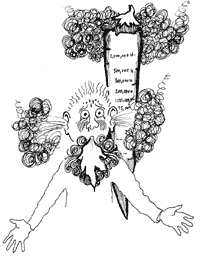Pucker up: Just how hot is hot?

DRAWING BY DEBORAH DERR McCLINTOCK
Q. How hot can spicy foods get? Could eaters injure themselves in indulging their fiery hot tastes? – E.A. McIlhenny
A. The "heat" is from the chemical capsaicin in the pepper, causing a sensation of pain– especially in the eyes when used in pepper spray– but doing no lasting damage, says Washington State University food research technologist Michael Costello. Temporary reactions might include numbness, heavy sweating, intestinal cramps.
Spicy heat is measured in "Scoville Units," relating to the concentration of capsaicin in the food: Most bell/sweet pepper varieties are in the 0-100 Units range; 2,500-5,000 Units includes jalapeno and mirasol peppers. The habanero pepper has long been ranked as the hottest pepper, averaging 200,000-300,000 Units. The Guinness Book of World Records lists the "Red Savina" cultivar as the hottest of all cultivated habaneros at 577,000 Units, although aficionados rank the Francisca cultivar as even hotter. "It just hasn't been tested by Guinness yet."
Recently however, the Naga Jolokia pepper (capsicum frutescens) of India has been measured to be 50 percent hotter than the hottest habanero, says Costello. As hot as it is, it's a staple in the northeastern region of India where it grows wild. This is the hottest known pepper that one could eat, at about 1,000,000 Scoville Units. "The theoretical limit would be 16,000,000, for pure, concentrated capsaicin. Were you to do that, you wouldn't die, however much you might wish it."
Q. Have you heard of birds that will get on the backs of other birds to go South? –A. Hale
A. Migration is an incredibly energetically costly endeavor, and birds are pushed to their limits completing migration successfully, says John Rowden, Columbia researcher and curator of animals at Central Park Zoo. There is no way a bird could accommodate a passenger. It's possible the piggyback migrator notion developed from the fact that some birds will "draft" off others while flying in formation. "By flying close to the side of a leading bird, the drafter will gain some energetic benefit, without negatively affecting the leading bird," Rowden says.
To prove the V-formation energy savings, a French team studied pelicans, who not only fly in "squadron" but also flap in time with their leader, gliding often, as reported by BBC News. The researchers taped heart monitors to the birds' backs and watched the heartbeat rates go down during flights in formation compared with solo flights.
Q. Is it "karat" or "carat" that brings home the gold?
A. Karats are a measure of gold's purity, with 24- karat being 100 percent pure, 14-karat 58 percent pure (because 14/24 = 0.58) with 42 percent other metals, say Jeffrey Bennett and William Briggs in Using and Understanding Mathematics. A carat is a measure of weight, 0.2 grams, for diamonds and other gems. So when you buy gold jewelry, you'll be told its weight (in grams) and its purity. The tradeoff is that higher purity gold is softer and deforms easily, whereas the metals mixed in with lower karat gold– usually silver and copper– add strength.
The tradeoff with gems is among weight, color, clarity. "For example, if you're looking for a round diamond, $10,000 might buy you either a 1-carat diamond with good color and clarity or a 2-carat diamond with poorer color and clarity," Bennett says. The Cullinan Diamond at 3,106 carats = 621 g = 1.4 lb was the largest ever found, in 1905 in Transvaal, South Africa, presented to King Edward VII of England, later cut into nine stones including the 530.20-carat Star of Africa, set in the Royal Scepter displayed in the Tower of London.
Send Strange questions to brothers Bill and Rich at .
#